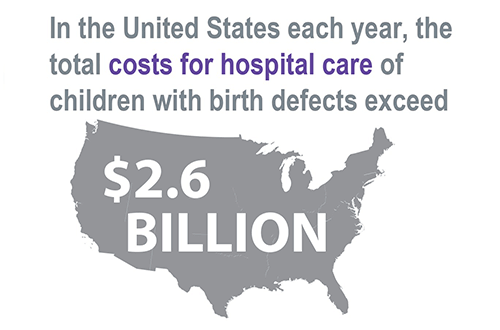Saving Babies Through Birth Defects Prevention and Research
 CDC’s National Center on Birth Defects and Developmental Disabilities (NCBDDD) is working toward a day when all babies are born with the best health possible.
CDC’s National Center on Birth Defects and Developmental Disabilities (NCBDDD) is working toward a day when all babies are born with the best health possible.

Birth defects are common, costly, and critical. Every 4 ½ minutes, a baby is born with a major birth defect in the United States. Babies born with a birth defect are more likely to die before their first birthday compared to babies born without a birth defect. Babies who survive and live with birth defects can have lifelong challenges.
NCBDDD’s state-based birth defects tracking and public health research provide a wealth of information used to identify causes of birth defects, find opportunities to prevent them, and improve the health of those living with birth defects.
Budget and Funding
Accomplishments
- Interviewed more than 1,400 mothers of newborns with and without birth defects for the Birth Defects Study To Evaluate Pregnancy exposureS (BD-STEPS). Results from BD-STEPS will provide more knowledge about the factors that might increase or decrease the risk of having a baby with a birth defect.
- Continued our work in the United States to prevent neural tube defects—serious birth defects of the brain and spine—by providing scientific assistance to the Corn Masa Flour Working Group on their successful petition to the U.S. Food and Drug Administration (FDA). This FDA approval allows for the addition of folic acid to corn masa flour and other corn-based products, such as corn tortilla chips, which can help prevent neural tube defects. Through our Birth Defects COUNT global initiative, we provided expert input to our partners in India, the country with the highest burden of neural tube defects, which led to revised standards for fortifying foods with appropriate amounts of folic acid so as to prevent many neural tube defects.
- Expanded research and delivered reliable information about safer medication use in pregnancy through Treating for Two. Presented new information on the frequency of filling prescriptions for antidepressants among women of reproductive age.
- Provided new data and research on fetal alcohol spectrum disorders (FASDs), including a report on alcohol use during pregnancy, which estimated more than 3 million U.S. women are at risk for an alcohol-exposed pregnancy. Provided guidance for healthcare clinicians on the identification, diagnosis, and care for children and teens with behavioral problems associated with prenatal alcohol exposure. Partnered with the Administration for Children and Families and initiated project to identify children within the child welfare system who were exposed to alcohol before birth, thereby improving their care.
- Presented updated estimates on the number of people living in the United States with congenital heart defects (CHDs), which helps policymakers and healthcare systems plan to meet the health needs of the growing population of adults with CHDs.

Looking to the Future
Our ongoing state-based birth defects tracking system and public health research continue to form the scientific foundation for preventing birth defects and helping people thrive throughout their lives. Our research helps us to better understand the causes of birth defects and the lifelong cost and quality of life issues that affect those with birth defects and their families. Together, with our partners, we continue to work toward the day when all babies are born with the best possible health.
Notable 2016 Scientific Publications
Dasgupta S, et al. Patterns in Zika virus testing and infection, by report of symptoms and pregnancy status — United States, January 3–March 5, 2016. MMWR Morb Mortal Wkly Rep. 2016 Apr 22;65(15);395-399.
Dawson AL, et al. Twinning and major birth defects, National Birth Defects Prevention Study, 1997-2007. J Epidemiol Community Health. 2016 Nov;70(11):1114-21.
Dawson AL, et al. Antidepressant prescription claims among reproductive-aged women with private employer-sponsored insurance – United States 2008-2013. MMWR Morb Mortal Wkly Rep. 2016 Jan 29;65(3):41-6.
Gilboa SM, et al. Congenital heart defects in the United States: Estimating the magnitude of the affected population in 2010. Circulation. 2016 Jul 12;134(2):101-9.
Green PP, et al. Vital signs: Alcohol-exposed pregnancies — United States, 2011–2013. MMWR Morb Mortal Wkly Rep. 2016 Feb 5;65(4);91-7.
Grosse SD, et al. Retrospective assessment of cost savings from prevention: Folic acid fortification and spina bifida in the U.S. Am J Prev Med. 2016 May;50(5Suppl 1):S74-S80.
Hagan JF, et al. Neurobehavioral disorder associated with prenatal alcohol exposure. Pediatrics.2016 Sep 27;138(4):e20151553.
Orozco AM, et al. Characteristics of US adults aged ≥ 19 years with a usual daily folic acid intake above the tolerable upper intake level: National Health and Nutrition Examination Survey 2003-2010. Nutrients. 2016 8(4):195.
Razzaghi H, et al. Impact of missing data for body mass index in an epidemiologic study. Matern Child Health J. 2016 Jul;20(7):1497-505.
Yeung LF, et al. Ascertaining the burden of birth defects. Am J Prev Med. 2016 May;50(5):672-3.
Zaganjor I, et al. Describing the prevalence of neural tube defects worldwide: A systematic literature review. PLoS One. 2016 Apr 11;11(4):e0151586.
Spotlight On: MotherToBaby, a service of the Organization of Teratology Information Specialists
This spotlight was contributed by Christina Chambers, PhD, MPH, MotherToBaby epidemiologist
MotherToBaby, a service of the nonprofit Organization of Teratology Information Specialists, provides free, evidence-based information to the public and healthcare providers online and by telephone about medications and other exposures during pregnancy and breastfeeding. “You have given me so much insight, truth, and hope about being pregnant and being a mom,” stated R.M., an expecting mom from Georgia who contacted MotherToBaby. Truth about birth defects is what MotherToBaby strives for and hope for new prevention methods is what it often achieves.
This work is critical. Birth defects affect 1 in 33 infants. A key component of the National Center on Birth Defects and Developmental Disabilities’ (NCBDDDs’) mission includes birth defects prevention. MotherToBaby has worked closely with NCBDDD on efforts affecting the public. For example, in 2005, MotherToBaby partnered with NCBDDD to provide fact sheets on exposures, such as infections, medications, and chemicals, affecting pregnant women during Hurricane Katrina. In 2009-2010, MotherToBaby worked with NCBDDD to develop a preparedness plan for pregnant women in advance of the pandemic H1N1 influenza outbreak. In 2016, MotherToBaby partnered with NCBDDD to provide expert consultation to concerned women regarding the Zika virus disease.
For more than 15 years, MotherToBaby has contributed information on the safety of medications and vaccines during pregnancy by conducting critical observational research studies. In 2016, we had ongoing studies on asthma, autoimmune and immune-mediated conditions (such as rheumatoid arthritis, psoriasis, Crohn disease and ulcerative colitis, and multiple sclerosis), seasonal flu vaccine, and the pertussis vaccine. These much needed studies allow women and healthcare providers to make informed decisions to prevent or reduce the risk of birth defects while simultaneously trying to keep the mom healthy.
- Page last reviewed: January 24, 2017
- Page last updated: January 24, 2017
- Content source:


 ShareCompartir
ShareCompartir

